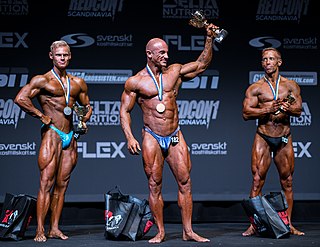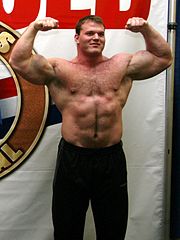
Bodybuilding is the practice of progressive resistance exercise to build, control, and develop one's muscles via hypertrophy. An individual who engages in this activity is referred to as a bodybuilder. It is primarily undertaken for aesthetic purposes over functional ones, distinguishing it from similar activities such as powerlifting and calisthenics.

Weightlifting is a sport in which athletes compete in lifting a barbell loaded with weight plates from the ground to overhead, with the aim of successfully lifting the heaviest weights. Athletes compete in two specific ways of lifting the barbell overhead. The snatch is a wide-grip lift, in which the weighted barbell is lifted overhead in one motion. The clean and jerk is a combination lift, in which the weight is first taken from the ground to the front of the shoulders, and then from the shoulders to over the head. The sport formerly included a third lift/event known as clean and press.

Powerlifting is a strength sport that consists of three attempts at maximal weight on three lifts: squat, bench press, and deadlift. As in the sport of Olympic weightlifting, it involves the athlete attempting a maximal weight single-lift effort of a barbell loaded with weight plates. Powerlifting evolved from a sport known as "odd lifts", which followed the same three-attempt format but used a wider variety of events, akin to strongman competition. Eventually, odd lifts became standardized to the current three.

The clean and jerk is a composite of two weightlifting movements, most often performed with a barbell: the clean and the jerk. During the clean, the lifter moves the barbell from the floor to a racked position across the deltoids, without resting fully on the clavicles. During the jerk, the lifter raises the barbell to a stationary position above the head, finishing with straight arms and legs, and the feet in the same plane as the torso and barbell.

The bench press, or chest press, is a weight training exercise where a person presses a weight upwards while lying horizontally on a weight training bench. The bench press is a compound movement, with the primary muscles involved being the pectoralis major, the anterior deltoids, and the triceps brachii. Other muscles located in the back, legs and core are involved for stabilization. A barbell is generally used to hold the weight, but a pair of dumbbells can also be used.

A barbell is a piece of exercise equipment used in weight training, bodybuilding, weightlifting, powerlifting and strongman, consisting of a long bar, usually with weights attached at each end.

Strength training, also known as weight training or resistance training, involves the performance of physical exercises that are designed to improve strength and endurance. It is often associated with the lifting of weights. It can also incorporate a variety of training techniques such as bodyweight exercises, isometrics, and plyometrics.

A squat is a strength exercise in which the trainee lowers their hips from a standing position and then stands back up. During the descent, the hip and knee joints flex while the ankle joint dorsiflexes; conversely the hip and knee joints extend and the ankle joint plantarflexes when standing up. Squats also help the hip muscles.
The snatch is the first of two lifts contested in the sport of weightlifting followed by the clean and jerk. The objective of the snatch is to lift the barbell from the ground to overhead in one continuous motion. There are four main styles of snatch used: snatch, split snatch, power snatch, and muscle snatch. The full lift is the most common style used in competition, while power snatches and muscle snatches are mostly used for training purposes, and split snatches are rarely used. Any of these lifts can be performed from the floor, from the hang position, or from blocks. In competition, only lifts from the floor are allowed.

Paul Edward Anderson was an American weightlifter, strongman, and powerlifter. He was an Olympic gold medalist, a world champion, and a two-time national champion in Olympic weightlifting. Anderson contributed significantly to the development of competitive powerlifting.

In weight training, a kettlebell is a cast-iron or cast-steel ball with a handle attached to the top. It is used to perform many types of exercises, including ballistic exercises that combine cardiovascular, strength and flexibility training. Kettlebells are the primary equipment used in the weight-lifting sport of kettlebell lifting.
The clean and press is a two-part weight training exercise whereby a loaded barbell is lifted from the floor to the shoulders and pushed overhead. The lift was a component of the sport of Olympic weightlifting from 1928 to 1972, but was removed due to difficulties in judging proper technique.

Progressive overload is a method of strength training and hypertrophy training that advocates for the gradual increase of the stress placed upon the musculoskeletal and nervous system. The principle of progressive overload suggests that the continual increase in the total workload during training sessions will stimulate muscle growth and strength gain by muscle hypertrophy. This improvement in overall performance will, in turn, allow the athlete to keep increasing the intensity of their training sessions.

Muscle hypertrophy or muscle building involves a hypertrophy or increase in size of skeletal muscle through a growth in size of its component cells. Two factors contribute to hypertrophy: sarcoplasmic hypertrophy, which focuses more on increased muscle glycogen storage; and myofibrillar hypertrophy, which focuses more on increased myofibril size. It is the primary focus of bodybuilding-related activities.

The overhead press, also known as the shoulder press, strict press or military press, is an upper-body weight training exercise in which the trainee presses a weight overhead while seated or standing. It is mainly used to develop the anterior deltoid muscles of the shoulder. The standing version was once a component of the sport of Olympic weightlifting as part of the clean and press movement, but was removed in 1972 due to difficulties in judging proper technique.
York Barbell is an American-based international manufacturer of fitness products. Bob Hoffman, named "Father of World Weightlifting" by the International Weightlifting Federation, bought the Milo Barbell Company and founded York Barbell in 1932. As a prolific writer of books and articles, Hoffman promoted the benefits of exercise and nutrition.

Thomas Inch was a British strongman, who held the titles of Britain's Strongest Youth and Britain's Strong Man.
The metabolic window is a term used in strength training to describe the 2 hour period after exercise during which nutrition can shift the body from a catabolic state to an anabolic one. Specifically, it is during this period that the intake of protein and carbohydrates can aid in the increase of muscle mass.
Football strength is a training regime, considered the most complex physical quality to be developed by an athlete. The training regime, exercises used, how the exercises are performed, and the types of equipment all play important roles in achieving desired results.

Power training typically involves exercises which apply the maximum amount of force as fast as possible; on the basis that strength + speed = power. Jumping with weights or throwing weights are two examples of power training exercises. Regular weight training exercises such as the clean and jerk and power clean may also be considered as being power training exercises due to the explosive speed required to complete the lifts. Power training may also involve contrasting exercises such as heavy lifts and plyometrics, known as complex training, in an attempt to combine the maximal lifting exertions with dynamic movements. This combination of a high strength exercise with a high speed exercise may lead to an increased ability to apply power. Power training frequently specifically utilises two physiological processes which increase in conjunction with one another during exercise. These are deep breathing, which results in increased intra-abdominal pressure; and post-activation potentation, which is the enhanced activation of the nervous system and increased muscle fibre recruitment. Power training programmes may be shaped to increase the trainee's ability to apply power in general, to meet sports specific criteria, or both.


















